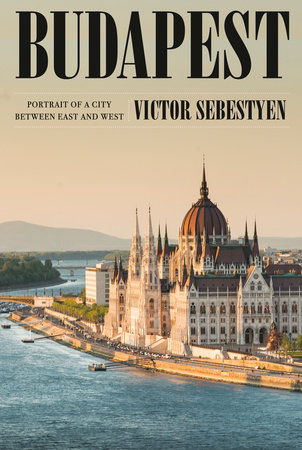Budapest: Portrait of a City Between East and West
- By Victor Sebestyen
- Pantheon
- 418 pp.
- Reviewed by Anne Cassidy
- September 13, 2023
A fascinating chronicle of Hungary’s storied capital.

Cities have taken a hit lately. The pandemic made us fear them, and remote work is hollowing them out. But for anyone who doubts the city’s place in history, its quintessential importance to nations and peoples, author Victor Sebestyen has a response. His Budapest: Portrait of a City Between East and West charts Hungary’s capital from its beginnings as an ancient Celtic fort to its 21st-century rebirth. And while there were periods when the city suffered greatly at the hands of invading hordes, its significance has never been in question.
In many ways, the history of Budapest is the history of Hungary. And since Hungary is a country that’s often “punched well above its weight,” Sebestyen writes, events that began in Budapest “have proved to be of world significance.”
He’s not kidding. What plays out here are some crucial historical events: the fall of Rome, the Mongol invasion, Ottoman rule (responsible for the country’s bathhouses, paprika, and love of coffee), the Austro-Hungarian empire, and the horrors of the 20th century. Hungary was on the losing side in both World War I and World War II and spent decades behind the Iron Curtain.
No wonder, then, that isolation is a theme, beginning with linguistic isolation. The Hungarian language is an orphan tongue so difficult to learn that even the debates about its 18th-century revival were conducted in German. And then there is political isolation: Hungary received no support when the Turks occupied it, the Austrians crushed a revolution, and the Soviet Union suppressed an independence movement in 1956. “We are the most forsaken of all peoples on this earth,” lamented the Hungarian poet Sándor Petōfi.
The 1956 uprising, the subject of Sebestyen’s first book, was a turning point for his own family, who fled the country in its wake. The author was an infant then, so his first impressions of Hungary came from wistful dinner-table conversations where his exiled parents reminisced about the hills and concert halls of their beloved Budapest.
Sebestyen came to know the city first-hand while covering the collapse of the Soviet Union as a journalist in the 1980s, and he began writing this book in one of his favorite Budapest cafés. “It is difficult to overstate the importance of the coffee house in Budapest’s lifestyle and culture,” he writes. These places are the center of intellectual life, full of conversation, creativity, and political intrigue. In an often-stratified society, they’ve been where people come together. The country itself has seldom been democratic, but its coffee houses tend to be.
Budapest is filled with fun footnotes and wry asides: the many streets named for Ferenc Rákóczi, for example, a rebel “whose extraordinary life is a quintessential Hungarian story of heroic defeat,” or visiting actor Richard Burton’s boorish behavior at a British embassy party in 1972, which was “gossiped about in Budapest for years afterward.”
One footnote mentions the location of an excellent museum of Hungarian Jewish history. Although Hungarian Jews faced persecution for centuries, 90 percent of Budapest’s Jewish population survived World War II, “a higher number than anywhere else within Hitler’s Europe.”
For most of its history, Budapest consisted of two distinct cities: Buda on the western side of the Danube River — traditionally Catholic and conservative, home to the nobility — and Pest to the east: entrepreneurial, lively, a magnet for immigrants. This basic duality has come in handy through the years, giving the city the breadth and perspective to look both east toward Asia and west toward Europe.
Although the Danube flows sedately through the city now, the river was wilder in the old days. The Great Flood of 1838 left nearly half of Pest’s population homeless but led to stricter building codes and a series of relief concerts given by flamboyant pianist and composer Franz Liszt, a native son.
Liszt is just one of many artists, writers, and politicians whose stories are woven into the book.
Another is Count István Széchenyi, who helped bring modern Budapest into being by ensuring there was a permanent bridge between Buda and Pest — according to one theory, because he had a mistress on each side. An updated version of Széchenyi’s 19th-century span contributes to contemporary Budapest’s fairytale charm. That and the Parliament Building, which has been described as a “Turkish bath crossed with a Gothic chapel.”
It’s the Parliament Building, in fact, that graces the cover of this volume and gives it something of a guidebook feel. Budapest is not a guidebook, though. It’s more expansive than that. But after reading it — after absorbing the tragic and inspiring history of Hungary and its capital — you’ll want a guidebook to see for yourself the city that Sebestyen so lovingly brings to life.
Anne Cassidy has been published in many national magazines and newspapers, including the Washington Post, the New York Times, and the Christian Science Monitor. She blogs daily at “A Walker in the Suburbs.”

